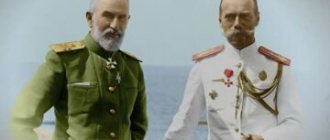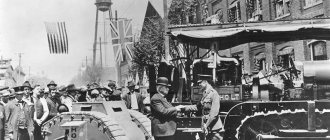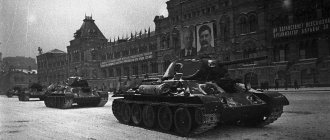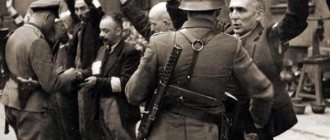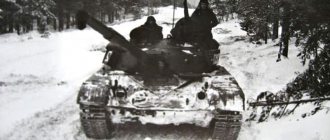The SS troops belonged to the SS organization; service in them was not considered state service, even if it was legally equivalent to such. The military uniform of SS soldiers is quite recognizable all over the world; most often this black uniform is associated with the organization itself. It is known that the uniforms for SS employees during the Holocaust were sewn by prisoners of the Buchenwald concentration camp.
Form history
Initially, soldiers of the SS troops (also “Waffen SS”) wore gray uniforms, very similar to the uniform of stormtroopers of the regular German army. In 1930, the same well-known black uniform was introduced, which was supposed to emphasize the difference between the troops and the rest and determine the elitism of the unit. By 1939, SS officers received a white dress uniform, and from 1934, a gray one was introduced, intended for field battles. The gray military uniform differed from the black one only in color.
Additionally, SS soldiers were entitled to a black overcoat, which, with the introduction of the gray uniform, was replaced by a double-breasted, respectively, gray overcoat. High-ranking officers were allowed to wear their overcoat unbuttoned by the top three buttons so that the colored distinctive stripes . Subsequently, holders of the Knight's Cross received the same right (in 1941), who were allowed to display the award.
women's uniform consisted of a gray jacket and skirt , and a black cap with the SS eagle.
black ceremonial club jacket
It should be noted that in fact the black uniform was the uniform of the SS organization specifically, and not the troops: only SS members had the right to wear this uniform; transferred Wehrmacht soldiers were not allowed to use it. By 1944, the wearing of this black uniform was officially abolished, although in fact by 1939 it was used only on special occasions.
Features
The SS uniform had a number of distinctive features that are easily remembered even now, after the disbandment of the organization:
- The SS emblem of two German "Sig" runes was used on uniform insignia. Only ethnic Germans - Aryans - were allowed to wear runes on their uniforms; foreign members of the Waffen SS did not have the right to use this symbolism.
- “Death's Head” - at first, a metal round cockade the cap . Later it was used on the buttonholes of soldiers of the 3rd Tank Division.
- The red armband with a black swastika on a white background was worn by members of the SS and stood out significantly against the background of the black dress uniform.
- The image of an eagle with outstretched wings and a swastika (formerly the coat of arms of Nazi Germany) eventually replaced skulls on cap badges and began to be embroidered on the sleeves of uniforms.
camouflage pattern differed from the Wehrmacht camouflage. Instead of the conventional pattern design with parallel lines applied, creating the so-called “rain effect,” woody and plant patterns were used. Since 1938, the following camouflage elements of the SS uniform have been adopted: camouflage jackets , reversible covers for helmets and face masks On camouflage clothing it was necessary to wear green stripes During campaigns, a set of stripes was also used, each of which denoted one or another military qualification.
SS – BLACK ORDER
“Himmler, and Hitler too, needed not just a collection of rowdies and criminal elements, which the SA and SS were at the first stage, but a fighting union of disciplined soldiers loyal to the Fuhrer, something purely military and at the same time... not military. The Nazis and their elite did not call themselves soldiers, but fighters, and in 1940 Himmler even said;
“Young Germans, who stand out for their behavior and character, want to be more than soldiers...”
For Himmler, the SS was more than a clique of party fanatics who destroyed the enemies of the Third Reich. This was the order of the Nordic race that he extolled - a mysterious brotherhood inspired by stories of the Teutonic knights and medieval legends.
According to many SS researchers, it was an order built on the principles of the Jesuit order. Hitler himself repeatedly called Himmler “my Ignatius of Loyola.”
The first thing the creators of the order did was make it extremely difficult to join it. In mid-1933, Himmler temporarily stopped accepting new members into the SS. Between 1933 and 1935, 60,000 people were expelled from the SS. Himmler himself stated about this purge:
“Not a single person was accepted anymore. And from the end of 1933 to the end of 1935, we excluded everyone who did not suit us.”
The selection was based on racial principles. The “pedigrees” of the SS men had to be one hundred percent “pure”. The requirement of racial purity also extended to the wives of SS men. In 1931, Himmler issued an order for permission to marry.
To get into the SS you had to go through a sieve of “racial selection”. Almost everything came down to pieces of paper – a questionnaire. Moreover, the requirements for officers and lower ranks were slightly different.
Lower ranks had to submit certificates stating that their ancestors had been Aryans since 1800; commanders or candidates for commanders were required to certify that their direct relatives had no admixture of non-Aryan blood since 1750. A full-length photograph of the candidate was also presented.
“Dr. Bruno Schulz, SS Hauptsturmführer and professor, based on the research of racial theorists, created a special scale, dividing all possible candidates into five groups:
1) purely “Nordic” group;
2) predominantly “Nordic” or “phalic” group;
3) a group “consisting of harmoniously mixed people of both races” with “a slight admixture of Alpine, Dinaric and Mediterranean blood”;
4) a group of “hybrids where Alpine or Oriental blood predominates”;
5) a group of “mestizo of non-European origin.”
Only those people who belonged to the first three groups could apply to join the SS. However, Himmler assured that in a few decades the members of the SS would be exclusively pure Aryans (Nordic group), and in 120 years the entire German people would turn into blue-eyed and blond-haired Vikings.
In addition, the candidate had to have certain, strictly standardized proportions. An SS man should not have had a disproportionate figure. If no particular physical defects were found in the candidate, and he passed the questionnaire, this did not mean that this lucky person immediately became a full-fledged SS man.
He still had a long way to go. On November 9, the next anniversary of the Beer Hall Putsch, the candidate was declared a recruit and allowed to wear a black uniform, but without buttonholes. The next stage came on January 30: the recruit received a preliminary SS certificate. A few months later, on April 20, Hitler’s birthday, the recruit received buttonholes and a permanent SS ID, after which he took the oath to Hitler:
“I swear to you, Adolf Hitler, Fuhrer and Chancellor of the German Reich, To be faithful and brave, Maintaining obedience until death.”
The oath of SS officers was stricter, for example the oath of a general sounded like this:
“As a Lieutenant General of the SS, I undertake to strictly ensure that only people who fully meet its high standards, whatever the merits of their parents or ancestors, enter the SS.
I will not deviate from this rule, even if I have to reject my own sons, daughters or relatives. In addition, I undertake to ensure that every year at least a quarter of the candidates for the SS are from people who are not the sons of members of the SS.
Popular articles: SS Runes
I swear to honor these obligations without violating allegiance to our Fuhrer Adolf Hitler and without disgracing the honor of my ancestors, so help me God.”
Initiation into the SS in the “special detachments” of the SS took place super solemnly. It was timed to coincide with the anniversary of the Beer Hall Putsch - the ceremony was held at 10 p.m., that is, in complete darkness, in Munich near the Feldherrnhalle.
Hitler himself was often present at the ceremony. By the light of torches, thousands of SS men took the oath. While members of the “special detachments” of the SS became full-fledged SS men a year after they passed the first examination, members of the “general SS” were subject to additional processing.
Having sworn an oath of allegiance to the Fuhrer on April 20, they passed the sports standards, because they were required to receive a sports badge. Next, the recruit took a “theoretical course”, memorized “questions” and “answers” and passed exams.
On October 1, the recruit went to serve his labor service, and then he was called up for a short time into the Wehrmacht. Only after this, having received a good reference from the Wehrmacht commanders, did he return to the SS again and on November 9th he became a 100% SS man.
This time, he took a new oath: he swore that he would choose his life partner, “solely on the basis of racial hereditarily healthy principles,” as well as with the consent of the department for racial affairs or Himmler himself, and only after that the candidate became a full member of the SS.
The obstacles facing the candidates were absolutely necessary: the future SS man immediately had to understand that he was entering the holy of holies of the Nazi state - an elite organization. He had to believe that he was counted not just among the elite, but among the double elite: the Germans were the elite of nations, the SS men were the elite of Germans.
American SS scholar John M. Steiner writes that all SS men “were convinced that they were a racial elite. As a result, the security detachments considered it both their duty and their “right” to decide whether others had the right to exist...”
Staying in the SS was accompanied by a number of rituals. The existing set of rules placed the SS men in a very special position.
The significance of these rules was that even the direct privileges of the SS men - they did not undergo compulsory service in the Wehrmacht, they were paid more than all other career military personnel - took the form of a kind of ideological asceticism according to the principle: to whom more is given, more will be asked .
The SS were not subject to the jurisdiction of ordinary courts. They had their own courts. There were other special rules for the SS, which had a purely “decorative” meaning: SS men were allowed duels,
“Every SS man has the right and duty to defend his honor by force of arms,” Himmler asserted. The SS man who was at fault had the opportunity to commit suicide.
Popular articles: Edelweiss Division on Elbrus.
True, in both cases permission from superiors and compliance with a host of bureaucratic formalities was required.
Experienced SS men wore a ring with the image of a death's head on the ring finger of their right hand. Particularly trusted persons received a “dagger of honor” and honorary daggers. Who exactly was awarded the honorary weapon depended personally on Himmler. Only SS men who graduated from cadet schools automatically received daggers.
In addition, there were many ceremonies and rituals in which the SS men were required to participate. All SS men had special holidays. Even ordinary “fighters” did not celebrate Christmas, New Year, or Easter.
The most important family holidays for the SS men were considered to be marriage and the birth of a child. SS men did not get married in church. Colleagues and always the boss came to the wedding. The chief gave a speech, the newlyweds were presented with bread and salt and handed a silver cup.
The newborn also received an SS gift - a silver bowl, a silver spoon and a blue silk bow. At the funeral, the commander of the SS detachment again gave a speech.
Instead of Christmas, all SS men celebrated the day of the “winter solstice”, as well as the “solstice” (the day of the vernal equinox), and then, like all of Germany, Hitler’s birthday, the anniversary of the Beer Hall Putsch and the anniversary of the seizure of power. However, the real mysticism began at those levels of the SS hierarchy where Himmler himself and his inner circle were located.
Himmler believed in black magic, transmigration of souls, easily “communicated with spirits,” and consulted with fortune-tellers and astrologers.
In addition, Himmler identified himself either with the mythical King of the Britons, Arthur, or with King Henry, whose spirit allegedly appeared to him and gave valuable instructions.
As Arthur, the Reichsführer SS observed a rather complex ritual. There were always exactly 12 people sitting at his table. In the SS he had 12 Obergruppenführers, who were considered the highest hierarchs of the order. These twelve had their own coats of arms, designed and made by artists and craftsmen of the "Ancestors' Heritage" department.
At the same time, Himmler did not forget King Henry I. On July 2, 1936, supposedly on the millennium since the death of Henry I, Himmler swore to his namesake in Quedlinburg Cathedral that he would “finish his work ... the enslavement of the Slavs.”
In 1937, the remains of Henry I were transferred to Quedlinburg Cathedral, and Himmler declared that the cathedral should become a place of pilgrimage for the SS. For several years in a row, on the anniversary of the death of Henry I, went to the cathedral and at exactly midnight went to the crypt under the altar, where he held conversations with the ashes of the king.
The main castle of the order was Wewelsburg Castle. Even during the Nazi election campaign in January 1933, Himmler was traveling through Westphalia, and the romantic castle of Grevenburg made a deep impression on him.
He thought about purchasing the same castle for SS purposes. On November 3, 1933, Himmler and members of the SS commission visited Wewelsburg and chose this castle.
In 1934, for a nominal fee of one mark per year, he rented a crumbling castle in Westphalia. The fortress, known as Wewelsburg, was allegedly built by the Huns. It got its name from a knight named Wevel von Buren. During medieval civil strife, Paderborn bishops hid in the castle
. In the 17th century, the fortress was rebuilt and took on its modern appearance. Himmler intended to turn the castle into the spiritual center of the SS and open a cadet school there for SS officers. A Wewelsburg department was even formed at his headquarters under the command of SS Standartenführer Taubert.
Popular Articles: The Holy Grail of “royal blood”?
The castle was initially used as a museum and ideological education college for SS officers as part of the General Directorate for Race and Resettlement, but in February 1935 it came under the control of the Reichsführer-SS headquarters.
Wewelsburg Castle
The radicalization of the Wewelsburg concept was pushed by a certain Wiligut, who accompanied Himmler during his visits to the castle. Wiligut predicted that the castle was destined to become a magical place in the future struggle between Europe and Asia. His idea was based on an old Westphalian legend that found romantic expression in a 19th-century poem.
It described the old shepherd's vision of the “Battle of the Birch Tree,” in which a huge army from the East would be finally defeated by the West. Wiligut reported this legend to Himmler, claiming that Wewelsburg would become a bastion against which the “invasion of the new Huns” would be defeated.
Karl Wolf recalled that Himmler was very moved by Wiligut's idea: it satisfied his own vision of the future role of the SS in defending Europe in the coming confrontation between West and East. After Himmler rented Wewelsburg, the castle was rebuilt (the architect Bartels was responsible for the reconstruction and modernization of the castle).
As a result, the personal chambers of the Reichsführer SS himself were built above the giant dining room in the southern wing, including a huge room for a weapons collection and a library with 12,000 volumes. Nearby there was a meeting room and a courtroom.
The architect placed Hitler's apartments in the same south wing. The castle contained rooms for twelve of Himmler's associates, who regularly met in the main hall - thirty-five meters long and fifteen meters wide - with a round oak table in the middle, sitting in huge chairs upholstered in pigskin and decorated with coats of arms. According to researcher SS Hoehne, these sessions were very similar to seances.
The basement of Wewelsburg was converted into a hall of the highest commanders, in which the coats of arms of the highest commanders of the SS were to be burned in the event of their death.
The final plan of Wewelsburg reflects Himmler's cult of the SS. The main hall of the castle was a huge round room under a vault in the north tower, decorated with the coat of arms of the Reichsführer SS; below, in the SS Obergruppenführer Hall, daily ceremonies were held.
In the outbuildings of the castle there were study rooms named and decorated in honor of the heroes of “Nordic mythology”: Widukind, King Henry, Henry the Lion, King Arthur and the Grail.
Site plans dating from 1940-1942 suggest the relocation of the surrounding villages over a considerable distance and the construction of a grandiose architectural complex consisting of halls, galleries, towers and turrets, fortress walls, made in the shape of a semicircle on the hillside of the main defense of the original medieval castle.
The project was supposed to be completed by 1960. Himmler apparently dreamed of creating the Vatican SS, the center of the thousand-year-old great German Reich. 13 million marks were spent on modernizing Wewelsburg.
However, Himmler saw Wewelsburg as only the beginning: the Reichsführer SS wanted “a cultural center of German greatness and the German past to be created in each standard and to be brought into the order and condition that would be worthy of a people with an ancient culture...”
Heinz Hoehne -Black Order of the SS. History of security detachments
Similar
Insignia
The ranks of Waffen SS soldiers did not differ from the ranks of Wehrmacht employees: the differences were only in form. The uniform used the same distinctive insignia, such as shoulder straps and embroidered buttonholes . SS officers wore insignia with the symbols of the organization both on shoulder straps and in buttonholes.
The shoulder straps of SS officers had a double backing, the upper one differing in color depending on the type of troops. The backing was edged with a silver cord. On the shoulder straps there were signs of belonging to one or another unit, metal or embroidered with silk threads. The shoulder straps themselves were made of gray braid, while their lining was invariably black. The bumps (or “stars”) on the shoulder straps, designed to indicate the officer’s rank, were bronze or gilded.
The buttonholes featured runic “zigs” on one, and rank insignia on the other. The employees of the 3rd Panzer Division, which was nicknamed "Death's Head" instead of "zig", had an image of a skull, which was previously worn as a cockade on the cap of SS men. The edges of the buttonholes were edged with twisted silk cords, and for generals they were covered with black velvet. They also used it to line the general's caps .
How it all began?
During the September party congress in Nuremberg, which went down in the history of the Third Reich as the “Congress of the Winners,” Reich Chancellor Adolf Hitler announced the creation of the “Adolf Hitler Standard” - a new unit based on those same Sonderkommando security forces. As a sign of gratitude for the faithful service, this unit of 600 people was given the name of the leader of the Reich. “Leibstandarte SS Adolf Hitler” (LAS), according to the Fuhrer’s plan, was to become the calling card of the Reich, a selected formation, the elite of the elites. That is why the requirements for personnel were extremely strict: height from 180 cm (later even from 184 cm), age from 23 to 30 years, excellent physical fitness, excellent health (in the first three years they were not accepted even with a single filling in the tooth ). German citizens wishing to join the most prestigious and high-status part of the SS also had to present documents confirming their “Aryan origin.” In addition, it was required to confirm loyalty to the ideals of National Socialism and not have a criminal past. In theory, of course, the LAS was supposed to be subordinate to the Reich SS Fuhrer Heinrich Himmler, but in fact, the Leibstandarte carried out only the orders of the Fuhrer and the orders of the unit commander Joseph “Sepp” Dietrich. Gruppenführer Dietrich, an old party member, a former driver and bodyguard of Hitler, enjoyed his boundless trust and therefore was not afraid to conflict with the all-powerful SS chief. The regiment of the Fuhrer's personal guard lived according to its own laws, without regard to the “black Jesuit” (that is what Joseph Dietrich nicknamed Himmler).

